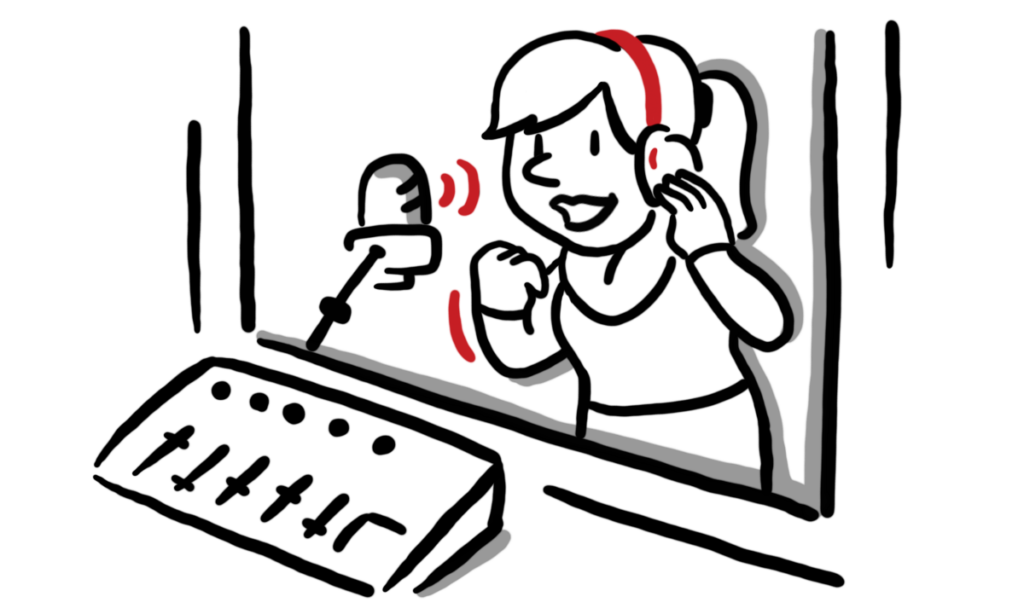Managing voice over recordings sessions for over 30 years, you learn a thing or two. I’m happy to share the simple lessons that have delivered consistently excellent results all these years. The video experts at TruScribe can help you with managing and creating a voice over recording session efficiently.
Use Professional Talent For You Voice Over Recording Session
There are many agencies that can help you find and hire voice over talent remotely. They allow you to search their talent pool and listen to multiple samples to find the right voice for your project. Making that selection is all about finding talent with the tone or range that can match your script. If you’re promoting a product or service, you might want to use an upbeat, enthusiastic tone with a sales spin. If you’re sharing important information, you might want to use a serious and authoritative tone. If you’re sharing helpful information, perhaps a friendly, conversational tone is best.

Environment Matters During Your Voice Over Recording Session
Unless you’re going for that raw, homemade, amateur vibe, be sure to use a professional recording environment. It doesn’t matter how great your microphone is, unless the environment around it is conditioned to avoid echo, it’s going to sound bad. Professional talent often have their own recording studios. Some are more advanced than others, but they should have the ability to deliver clean, crisp audio files. Moreover, they are accustomed to remotely managed recording sessions using a platform such as Zoom.
Prepare & Lead
Managing a voice over recording is a complex process that can require approval from multiple parties. This requires good preparation, organization, and communication to ensure that you end up with a great final product. Your responsibilities may include tracking script changes, directing the talent, recording notes to improve takes, informing your audio engineer of which takes you select, and even managing your client if they join the session. Have a plan, know your role, and don’t be afraid to lead the session. It’s also important to establish clear expectations with the talent regarding the session’s duration, any technical requirements on their part, and the process you plan to follow, all before starting the session.
Be Hospitable
Introductions are a great place to start, especially if you have a client participating in the voice over record session. Summarize the project so your client can affirm and provide additional context. This includes discussing the project’s tone, target audience, and any specific points that you’d like the talent to emphasize. The talent can ask clarifying questions, including anything that may be confusing about wording or pronunciations that might be tricky.
Housekeeping

Before you begin, discuss how the script should be broken down. Some voice actors prefer reading short sections at a time, others are willing to carry longer sections. You may find the talent runs out of breath in longer sections, or that reading line by line doesn’t blend as smoothly. Come prepared with a proposed numbering for sections of script. This allows the talent to plan their read and provides a nomenclature for tracking the takes that will be recorded. Before each section is recorded, direct the talent to slate it, for example, “Paragraph One, Take One.” It never hurts to have the talent start with a few warm-up reads.
Direct Tone
Next, clearly guide the tone, pacing and mood you want conveyed. To direct tone you can:
- Use descriptive words, for example, a friendly tone, use words like warm, welcoming, and approachable. If you want them to convey a sense of urgency or excitement, use words like ‘energetic,’ ‘enthusiastic,’ and ‘animated.’
- Discuss how you want the audience to feel as they listen.
- Demonstrate the desired tone yourself.
Ask the talent to read the first line or paragraph for tone. Provide specific feedback to help them adjust. Once you’re agreed and confident, move on to recording.
Clap. Snap. Click.
When recording a paragraph, there might be small stumbles or hiccups that don’t require a complete re-record of the paragraph, simply a redo of the word. The audio engineer can slice the correction into the original recording seamlessly. Before the talent makes the correction, ask them to precede the re-take with a clap or finger snap. Some talent use a clicker device. This produces a noticeable spike in the audio wave form that your audio engineer can easily recognize. It lets them know there is a correction to address.
Focus. Listen.

As the talent reads, remain focused on what is being said, and actively listen. Are they reading all the words in the script? Are they changing words inadvertently? Are they mispronouncing anything? Are the tone and pace consistent? Are they emphasizing the important parts? Are they saying the brand or product name in a positive way?
Track

As you listen, track along with the script and note any mistakes or necessary adjustments. It’s easiest to use a paper copy of the script and a pencil because you can develop a system of marks that allow you to quickly know where to find moments in the recording that require attention. For example, you might make a mark on the recording at any point where a missed word, mispronunciation, or stumble occurs by circling it. Symbols and short annotations that you can easily decode win the day, as you need to remain focused on every word the talent speaks.
Constructive, Actionable Feedback
After each take, provide constructive feedback to the talent on their performance. Allow the talent to assess their record, ask questions or make suggestions that could enhance the recording. Focus on one aspect at a time and provide specific guidance for how to improve it. Help the talent understand how they can improve their delivery and let them know when they’re doing a good job. At the end of the day, you need to help your talent perform their best so that you end up with the best final product.
Save A Backup Voice Over Recording Session
Even if you think the first take was perfect, record a second. Recording multiple takes can help you choose the take that best fits your needs. As the talent becomes comfortable with the reading, they build energy and introduce creative vocal flourishes that can surprise and delight you. And if your client will hear the takes after the session is over, you want to be sure you have options in case they don’t like the selected take. Make a choice about which take is best for your purposes and record that note for your audio engineer in the editing process. Provide accurate, clear session notes!
Organize & Save Your Voice Over Recording Session
Save all recordings and notes as backup in case revisions need to be made to the final product. Always update the original voice over recording session script to capture changes made during the recording session. Ideally, use track changes, color-coding or highlighting so the changes are visible. Also reflect the date of the recording, name of the voice talent and the booking agency. Save the session notes as well, so there’s a record of which take was selected for each line or paragraph. If you ever have to update the voiceover, you will thank yourself for doing this pre-planning!
Overall, managing a voice-over recording session requires great communication, preparation, and organization. The tips in this article will help ensure a successful voice-over recording and high-quality audio that exceeds your expectations.

